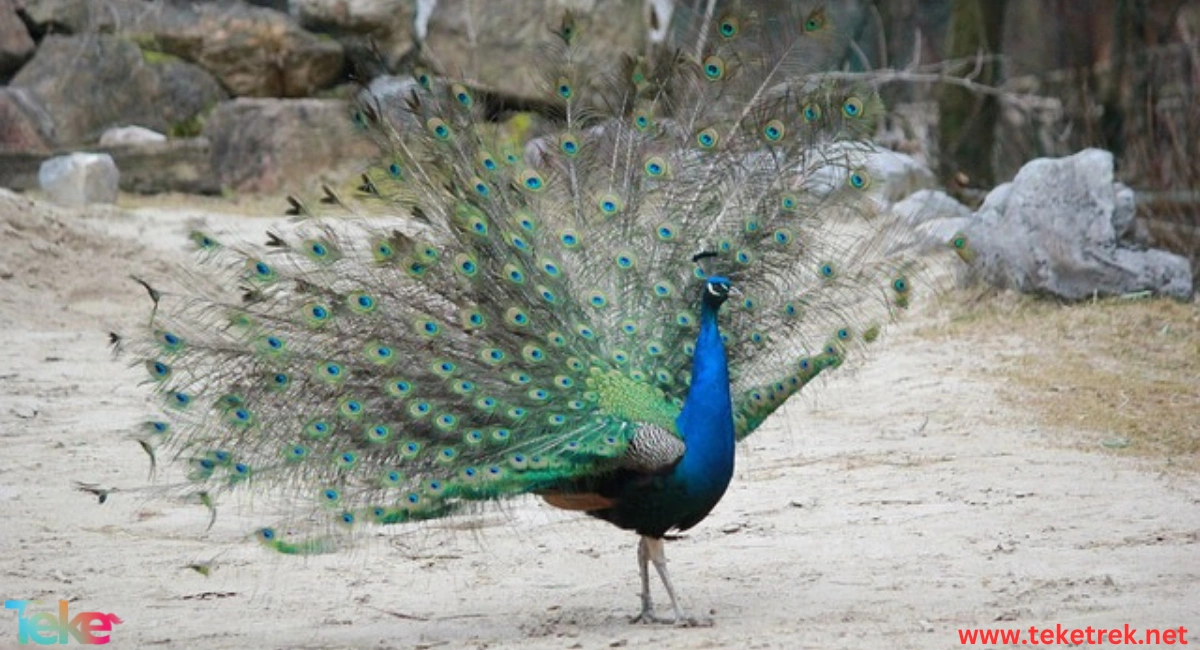The green peacock is a species of peacock, native to the tropical forests of Southeast Asia.
Due to the natural beauty of the Green Peafowl, these birds are sometimes targeted by the pet trade, feather collectors, and even hunters for their meat.
The Green Peafowl is highly desired by bird breeders in both the private and domestic sectors, despite its somewhat high care requirements.
Let’s learn more about it from teketrek.

Characteristics of the Green Peafowl
It is classified under the Animalia kingdom, Chordata phylum, Aves class, Peafowl family, and Green Peafowl genus.
Both male and female Green Peafowls have long upper tail coverts (which cover the actual tail underneath).
The male’s coverts extend up to 2 meters and are adorned with eye spots.
The female’s coverts are green and much shorter, covering only the tail.
The Green Peafowl’s neck and chest feathers are highly iridescent green, resembling dragon scales.
The Green Peafowl has vertical crests, long legs, heavy wings, and a long tail in silhouette.
The female’s crest has slightly wider columns, while the male’s crest is thinner but longer.
The Green Peafowl’s face skin is marked twice with bluish-white color.
Next to the ear, the Green Peafowl has a yellow crescent.
Green peafowl habitat: Where do peafowl live?
The Green Peafowl was once widespread in Southeast Asia but is now only sporadically found in China, Cambodia, Indonesia, Myanmar, Laos, Thailand, and Vietnam.
Green Peafowls are wild birds found in a wide range of habitats, including primary and secondary forests, as well as tropical and subtropical evergreens.
The Green Peafowl can also be found among bamboo, in grasslands, savannas, trees, and the edges of agricultural lands.
In Vietnam, the preferred habitat of the Green Peafowl is dry deciduous forests near water, away from human disturbance.
What is the behavior of the green peafowl?
Green Peafowls typically spend their time on or near the ground in tall grasses and reed plants.
At night, family units settle in trees at heights of 10-15 meters.
During the day, Green Peafowls can be found in small groups spending time foraging on the ground, drinking, preening, and resting in the shade.
Green Peafowls forage for food by scratching in leaf litter either early in the morning or at dusk.
The Green Peafowl is generally silent.
Green peafowl diet: What do green peafowl eat?
The Green Peafowl is carnivorous.
Its diet mainly consists of fruits, seeds, invertebrates, as well as reptiles, frogs, and rodents.
The Green Peafowl can also hunt venomous snakes.
Breeding stages of the Green Peafowl
The Green Peafowl is believed to be polygamous, meaning one male can mate with more than one female.
However, males are very solitary and territorial.
In captivity, the Green Peafowl is observed to be strongly monogamous (one male to one female).
Breeding occurs between April and June, during which time males perform courtship displays to attract females.
After mating, birds nest on the ground in a highly protected location, and the female lays 3 to 6 eggs.
The incubation period usually lasts 26-28 days by the female alone.
Chicks hatch with open eyes and are able to leave the nest shortly after hatching.
The chick can fly after two weeks of hatching but usually remains in the family group until the next breeding season.
Threats to the Green Peafowl
The Green Peafowl is endangered due to habitat loss and hunting for its beautiful feathers and for food.
Although there is no overlap in the natural range with the Indian Peafowl, hybridization still poses another threat, as the Indian Peafowl is introduced because it produces fertile hybrids.

Frequently Asked Questions about the Green Peafowl:
- Can green peafowl fly?
The peafowl cannot fly well. Although it has large wings, it relies on walking and running to escape danger.
- Can the Green Peafowl be seen in the wild?
The Green Peafowl lives in the tropical forests of Southeast Asia and prefers to live deep in the forests, avoiding human settlements.
- What is the advantage of the Green Peafowl over the Indian Peafowl?
The Green Peafowl is distinguished by its bright green plumage in both males and females and is considered less prolific than the blue Indian Peafowl and more solitary.
er scarcity, and agricultural practices.
- Is green peafowl extinct?
Yes, green peafowl is extinct.
- How many green peafowl are there?
The number of remaining green peacocks ranges from 15 to 30 thousand birds.
- How tall is the green peafowl?
The length of the green peacock ranges from 180 to 245 cm.
- Why are green peafowl endangered?
As a result of hunting, habitat loss and overfishing.
In conclusion
The Green Peafowl is a magnificent bird that embodies natural beauty with its vibrant colors and sparkling feathers that attract attention. It is a symbol of biodiversity and ecological balance in the regions where it lives, especially in Southeast Asia. However, the Green Peafowl faces multiple threats. Therefore, it is essential to enhance conservation efforts and preserve these unique birds to ensure their survival and continued contribution to global biodiversity. With these efforts, the Green Peafowl can remain a symbol of natural beauty and environmental richness for future generations.





